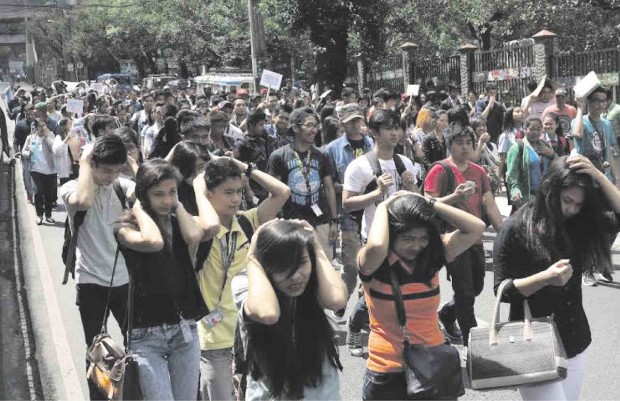Earthquake drill fails to shake Baguio folk

STUDENTS and residents join an earthquake drill in Baguio City but disaster response officials lament their lackluster response. EV ESPIRITU / INQUIRER NORTHERN LUZON
BAGUIO CITY, Philippines—In a city that was devastated by a 7.8-magnitude earthquake on July 16, 1990, the response of residents and students to an earthquake drill on Thursday was lackluster, to say the least. Some residents were ambivalent, even dismissive, when asked to participate in the exercise.
The “shake drill,” organized by the Office of Civil Defense (OCD), was also treated as a fun break from classroom work by some students, who were not born when the quake rocked mainland Luzon in 1990.
Traffic was stopped at 10:30 a.m., and office workers, students and residents were asked to step out of their buildings, schools and homes.
Some of them acted surprised. “Shake drill” posters and tarpaulins had been put up around the city, “but we thought it was just for a concert or a campaign rally,” said Kelley, 43, a mother who complained that the drill made her late for an appointment with a teacher.
The drill began with the blaring of the siren at City Hall, signaling the start of a simulated 7.2-magnitude temblor.
Article continues after this advertisementMayor Mauricio Domogan said the exercise was necessary for people who may have forgotten the destruction and chaos that followed the earthquake almost 26 years ago.
Article continues after this advertisementAside from Baguio, other cities severely hit by the quake were Dagupan and Cabanatuan, where more than a thousand people died.
Almost all of the city’s 128 villages took part in the exercise, according to the OCD. Policemen were deployed in the outskirt areas to manage traffic when the siren rang. Participants were required to duck before walking toward the nearest “evacuation” area.
Public utility vehicles were required to stop for a minute while the siren rang and to advise their passengers about the exercise. Some vehicles, however, were stuck for five minutes on Naguilian and Bokawkan roads leading from La Trinidad town in Benguet, because traffic flow toward downtown Session Road had slowed down to accommodate selected fire drill exercises.
The University of Baguio and the Baguio Economic Zone, which were hit hard by the 1990 earthquake, participated in the drill. The Philippine Military Academy Hospital and six major Baguio medical facilities, conducted their own evacuation drills, wheeling out “patients.”
The biggest groups of participants came from the University of the Cordilleras, SM City Baguio and a business process outsourcing firm on Governor Pack Road. The students and employees were marched out of buildings and led toward Burnham Park, where in 1990 a “tent city” was erected for quake victims. With a report from EV Espiritu, Inquirer Northern Luzon